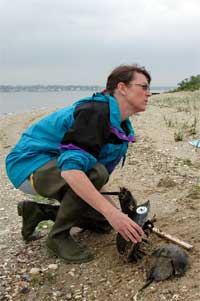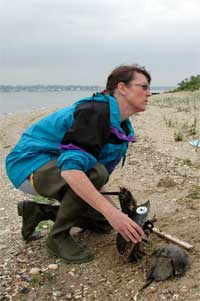 The award honors James-Pirri for her 12 years of research on salt marsh ecology and related studies at numerous national parks throughout the Northeast, including Minuteman National Historic Park, Boston Harbor Islands National Park, Saugus Ironworks National Historic Site and the Cape Cod National Seashore.
The award honors James-Pirri for her 12 years of research on salt marsh ecology and related studies at numerous national parks throughout the Northeast, including Minuteman National Historic Park, Boston Harbor Islands National Park, Saugus Ironworks National Historic Site and the Cape Cod National Seashore.
“My main focus is to try to help the Park Service better manage the resources in their parks,” said James-Pirri, a resident of Cumberland who earned a doctorate from URI in 1996.
“MJ has been instrumental in the development of long-term monitoring protocols for the Northeast Coastal and Barrier Network,” wrote National Park Service Regional Director Dennis Reidenbach in announcing the award. “Her original research on horseshoe crabs and salt marsh ecology has helped guide park management practices, and her work as a mentor to students at the University of Rhode Island has exposed new students to National Park Service resource management careers.”
While James-Pirri typically has four or five different Park Service research projects underway at once, she has worked nearly continuously on studies of horseshoe crabs since 2000, beginning at Cape Cod National Seashore and expanding last year to Fire Island National Seashore, Gateway National Recreation Area, and Sagamore Hill National Historic Site, all on Long Island.
“Back in 2000, we needed baseline data on horseshoe crabs in Cape Cod because park management was concerned about possible impacts of harvest for bait and for use by the medical industry, so I started conducting spawning surveys and tagging crabs to assess the population,” said James-Pirri.
In 2008, she became one of the first scientists to use radio telemetry to track the movements of horseshoe crabs.
“It’s important to know if the crabs remain in the bays and overwinter there or if they leave the bays and mix with the populations on the continental shelf,” she explained. “Depending on where they go, different management strategies may be required.”
This year she conducted telemetry studies of horseshoe crabs on Great South Bay, N.Y., and next year James-Pirri will begin the first telemetry studies of horseshoe crabs in the Park Service’s Jamaica Bay unit at Gateway National Recreation Area, where little is known about the horseshoe crabs that spawn there. She also hopes to collaborate with other scientists on a multi-species telemetry study in Jamaica Bay in the future.
“Identifying the locations and times when crabs are spawning helps feed into species management and law enforcement efforts to reduce poaching,” she said.
James-Pirri is one of more than a dozen scientists at the University of Rhode Island who are either employed by the National Park Service or who regularly conduct research funded by the Park Service.

